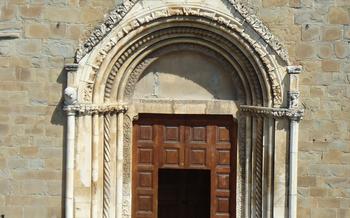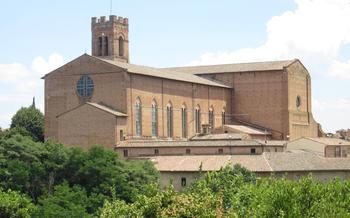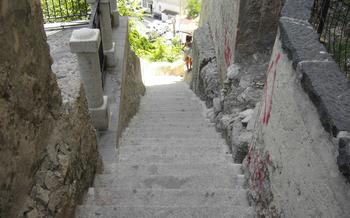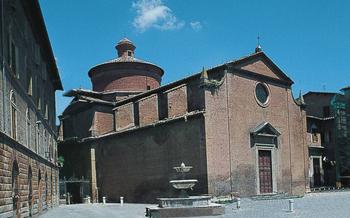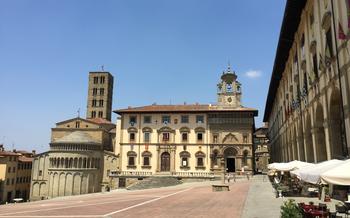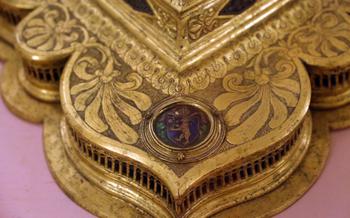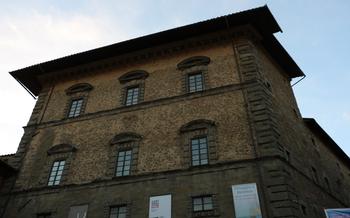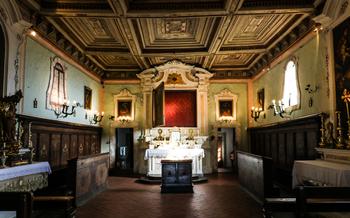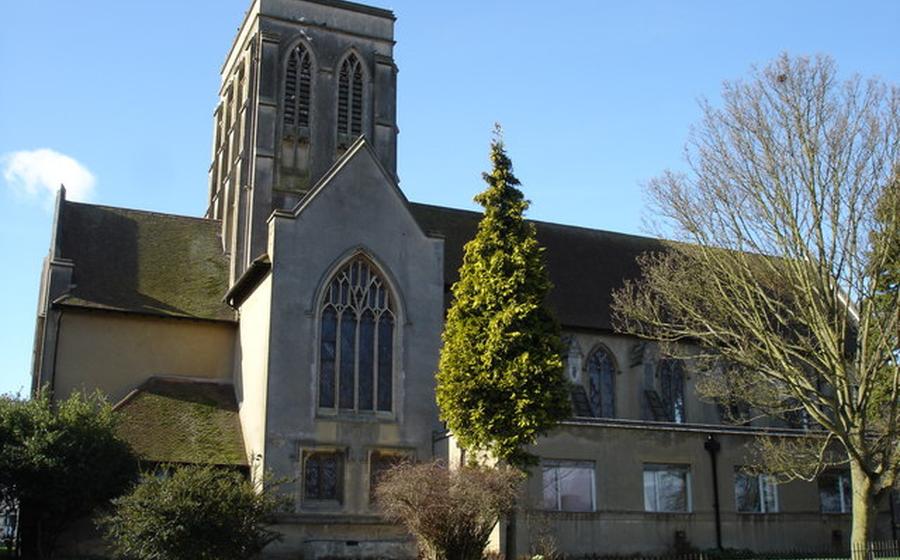
Chiesa di Sant'Agostino
- Chiesa di Sant'Agostino: A Journey Through History and Art in Cortona
- Historical Context
- Architectural Highlights
- Art and Frescoes
- Altarpiece and Sculptures
- Stained Glass Windows
- Cappella del Sacro Chiodo
- Piazza Sant'Agostino
- Cortona's Religious Heritage
- Restoration and Preservation
- Visiting Information
- Events and Exhibitions
- Hidden Gems
- Local Traditions and Legends
- Insider Tip:
Chiesa di Sant'Agostino: A Journey Through History and Art in Cortona
Nestled in the heart of the medieval hilltop town of Cortona, Italy, stands the Chiesa di Sant'Agostino, a remarkable architectural and artistic treasure that epitomizes the city's rich religious and cultural heritage. With its stunning facade, awe-inspiring frescoes, and intricate sculptures, the church is a testament to the devotion, artistry, and craftsmanship that flourished during the Renaissance period. Whether you're a passionate history buff, an art enthusiast, or simply seeking spiritual enlightenment, the Chiesa di Sant'Agostino offers a captivating journey through centuries of faith, artistry, and architectural splendor.
Historical Context
Cortona, an ancient Etruscan city perched atop a hill in Tuscany, boasts a rich history and cultural heritage. The arrival of the Augustinian Order in the 13th century marked a significant chapter in the city's religious life. The Augustinians, known for their dedication to education and community service, established a monastery and a church dedicated to Saint Augustine, their patron saint.
The construction of the Chiesa di Sant'Agostino began in the 14th century, reflecting the growing influence of the Augustinian Order in Cortona. The church's architectural style showcases a harmonious blend of Gothic and Renaissance elements, a testament to the transition period in which it was built.
Throughout history, the Chiesa di Sant'Agostino served as a spiritual and cultural hub for the city. It hosted religious ceremonies, processions, and gatherings, becoming an integral part of Cortona's social and religious fabric. The church's significance extended beyond its religious function, as it also served as a venue for artistic expression and intellectual discourse.
Architectural Highlights
The Chiesa di Sant'Agostino boasts an impressive facade that captivates visitors with its intricate carvings and sculptures. The harmonious Renaissance interior features elegant arches, columns, and a coffered ceiling, creating a sense of grandeur and spirituality. Notable architectural features include the apse, transepts, and side chapels, each showcasing unique design elements and contributing to the overall beauty of the church. The apse, with its semi-circular shape and frescoed ceiling, serves as the focal point of the sanctuary, while the transepts, with their barrel-vaulted ceilings, add depth and dimension to the interior space. The side chapels, adorned with elaborate altars and paintings, provide intimate spaces for prayer and contemplation.
Art and Frescoes
The Chiesa di Sant'Agostino is adorned with stunning frescoes that narrate the life of Saint Augustine and other religious figures, transforming its interior into a vibrant canvas of sacred art. The church's walls and ceiling are adorned with these exquisite paintings, each brushstroke contributing to the harmonious symphony of colors and forms.
The frescoes within the church are the masterpieces of renowned Renaissance artists, who employed various techniques to bring these religious scenes to life. The use of perspective, shading, and vibrant pigments creates a sense of depth and realism, drawing viewers into the depicted narratives.
These frescoes are not mere decorations; they hold profound religious and cultural significance. They served as a visual storytelling medium, educating the faithful about the lives of saints, biblical events, and moral teachings. The vivid depiction of these stories aimed to inspire devotion, evoke emotions, and strengthen the spiritual connection between the viewer and the divine.
The iconography of the frescoes is deeply rooted in Christian symbolism, with each element carrying specific meanings. Angels, saints, and biblical figures are portrayed with distinct attributes and gestures, inviting viewers to decipher their symbolic significance. The frescoes thus became a visual language, communicating complex theological concepts and stories in a captivating and accessible manner.
By studying these frescoes, visitors can gain a deeper understanding of the artistic and religious sensibilities of the Renaissance period. They offer a glimpse into the minds of the artists, the beliefs of the community, and the cultural and historical context that shaped the church's interior.
Altarpiece and Sculptures
The Chiesa di Sant'Agostino is adorned with a magnificent altarpiece, a masterpiece of Renaissance art. Created in the 15th century, the altarpiece features intricate carvings and vibrant colors, depicting scenes from the life of Christ and other religious figures. The central panel showcases the Crucifixion, with Mary, John the Evangelist, and other saints gathered around Jesus. The surrounding panels depict scenes such as the Annunciation, the Nativity, and the Resurrection.
The church also houses exquisite sculptures, showcasing the skill and artistry of Renaissance sculptors. Notable works include a Madonna and Child by Giovanni di Francesco, a Saint Augustine by Benedetto da Maiano, and a Saint Sebastian by Pietro Torrigiani. These sculptures are not merely decorative elements but powerful expressions of faith and devotion, capturing the essence of the saints they represent.
Stained Glass Windows
The Chiesa di Sant'Agostino is adorned with exquisite stained glass windows that add to its enchanting atmosphere. These luminous masterpieces bathe the interior with a symphony of colors, transforming the sacred space into a kaleidoscope of light and artistry. The intricate designs and iconography depicted in the windows tell biblical stories, depict religious figures, and evoke a sense of divine presence. The play of natural light through the stained glass creates a mystical ambiance, enhancing the spiritual experience of visitors. These windows are not just decorative elements; they are integral to the church's architecture, contributing to its visual splendor and artistic significance.
Cappella del Sacro Chiodo
The Cappella del Sacro Chiodo, or Chapel of the Holy Nail, is a side chapel within the Chiesa di Sant'Agostino that holds great significance for both religious and historical reasons. It is dedicated to the Holy Nail, a relic believed to have been used in the crucifixion of Jesus Christ. According to legend, the Holy Nail was discovered by Saint Helena, the mother of Emperor Constantine, during her pilgrimage to the Holy Land in the 4th century. She is said to have divided the nail into several parts, one of which was brought to Cortona by a noble family in the 13th century.
The chapel itself is a masterpiece of Renaissance architecture and artistry. Its walls are adorned with stunning frescoes depicting scenes from the life of Christ and the Virgin Mary. The intricate carvings and sculptures that embellish the altar and the walls further enhance the chapel's beauty and grandeur. The centerpiece of the chapel is the reliquary, which houses the Holy Nail. It is a magnificent work of art, adorned with precious stones and intricate goldsmithing.
Pilgrims from all over the world flock to Cortona to visit the Cappella del Sacro Chiodo and pay homage to the Holy Nail. The chapel is a testament to the deep faith and devotion of the people of Cortona and a symbol of the city's rich religious heritage.
Piazza Sant'Agostino
The Chiesa di Sant'Agostino stands proudly in Piazza Sant'Agostino, an enchanting square that exudes historical charm and offers panoramic vistas of the captivating Tuscan countryside. This piazza is not just a sacred space but also a vibrant gathering spot for locals and visitors alike.
The square is lined with medieval and Renaissance buildings, each with its unique architectural details, creating a harmonious ensemble that transports visitors back in time. The harmonious blend of architectural styles, from the Gothic to the Renaissance, reflects Cortona's rich and diverse past.
During the day, the piazza bustles with activity as locals go about their daily lives. The air is filled with the sounds of laughter, conversation, and the gentle hum of everyday life. In the evenings, the square takes on a more romantic ambiance as the sun casts a warm glow over the buildings and the lights illuminate the church's facade, creating a magical atmosphere.
Piazza Sant'Agostino is a place to relax on a bench, soak in the beauty of the surroundings, and savor the unique atmosphere of this enchanting square. The views from the piazza are simply breathtaking, offering panoramic vistas that stretch across the rolling hills, dotted with vineyards, olive groves, and ancient Etruscan ruins.
Whether you're seeking a moment of tranquility or a vibrant gathering spot, Piazza Sant'Agostino is the perfect place to experience the essence of Cortona and immerse yourself in its rich history and culture.
Cortona's Religious Heritage
The Chiesa di Sant'Agostino stands as a testament to Cortona's rich religious heritage. It played a pivotal role in shaping the city's spiritual and cultural identity throughout the centuries. As a prominent pilgrimage site, it attracted devout travelers seeking solace and connection with the divine. Its significance extended beyond Cortona, connecting it to other religious landmarks in the region.
The devotion to Saint Augustine, the patron saint of Cortona, is deeply ingrained in the city's history. The church served as a center for Augustinian spirituality, promoting the saint's teachings and fostering a sense of community among the faithful. The elaborate decoration of the church, with its stunning frescoes, sculptures, and stained-glass windows, reflects the profound reverence for Saint Augustine and the desire to honor his legacy.
Restoration and Preservation
The Chiesa di Sant'Agostino has undergone several restoration projects throughout its history to preserve its architectural integrity and artistic treasures. In the 19th century, a major restoration effort was undertaken to address structural issues and repair damage caused by time and neglect. During this time, the church's interior was meticulously cleaned, and its frescoes were restored to their former glory. More recently, in the early 21st century, another restoration project focused on stabilizing the church's foundations and reinforcing its structure to ensure its longevity. These restoration efforts have been crucial in safeguarding the church's heritage for future generations and maintaining its status as a beloved landmark in Cortona. However, the preservation of such a historically and artistically significant monument is an ongoing challenge. The church's custodians must balance the need to maintain its original features and integrity with the practical considerations of modern-day use and accessibility. This delicate balancing act ensures that the Chiesa di Sant'Agostino remains a vibrant and welcoming space for both religious worship and cultural appreciation.
Visiting Information
Planning a visit to the Chiesa di Sant'Agostino is a must for anyone exploring Cortona's cultural and historical treasures. The church is open to the public daily, with varying hours depending on the season. Admission is free of charge, allowing visitors to marvel at its splendor without any financial barriers. Guided tours are available upon request, providing an in-depth exploration of the church's history, architecture, and artwork. These tours offer valuable insights and enhance the overall experience for those seeking a deeper understanding of the site.
To make the most of your visit, consider planning your trip outside of peak tourist season to avoid large crowds. The shoulder months of spring and fall offer pleasant weather and fewer visitors, providing a more intimate and immersive experience. Additionally, checking the church's calendar beforehand can help you align your visit with special events or exhibitions that may be taking place during your stay. These events often showcase the church's cultural significance and offer unique opportunities to engage with its history and traditions.
To fully immerse yourself in Cortona's charm, combine your visit to the Chiesa di Sant'Agostino with other attractions and activities the city offers. Explore the narrow medieval streets, marvel at the panoramic views from the city walls, or indulge in the flavors of traditional Tuscan cuisine at local restaurants. Cortona is a treasure trove of historical, artistic, and culinary delights, and combining these experiences will create a truly unforgettable journey.
Events and Exhibitions
The Chiesa di Sant'Agostino is not only a place of worship but also a vibrant cultural center that hosts a variety of special events, concerts, exhibitions, and religious celebrations throughout the year. These events provide an opportunity to experience the church's artistic and spiritual heritage in a unique and immersive way.
One of the highlights is the annual "Cortona Sacred Music Festival," which takes place during the summer months. This prestigious festival features performances by renowned musicians and ensembles from around the world, filling the church with the sounds of classical, sacred, and contemporary music.
The church also hosts temporary art exhibitions showcasing the works of local and international artists, often inspired by the church's architecture, history, or religious themes. These exhibitions offer visitors a chance to admire contemporary interpretations of the church's rich heritage.
During religious holidays, such as Easter and Christmas, the chiesa di Sant'Agostino comes alive with special ceremonies, processions, and performances. These celebrations are a testament to the church's enduring role in the spiritual life of Cortona and provide a glimpse into the city's deep-rooted traditions.
Attending one of these events or exhibitions is an excellent way to experience the Chiesa di Sant'Agostino beyond its architectural and artistic merits. It allows visitors to immerse themselves in the church's vibrant cultural scene and gain a deeper understanding of its significance to the community of Cortona.
Hidden Gems
Beyond the main attractions, the Chiesa di Sant'Agostino holds hidden gems that add to its charm and mystique. In the sacristy, visitors can admire a stunning collection of sacred vestments, intricately embroidered with gold and silver threads. These exquisite garments, used in religious ceremonies, offer a glimpse into the church's rich history and liturgical traditions.
Another hidden gem is the small cloister garden, accessible from the sacristy. This tranquil oasis features a central fountain surrounded by lush vegetation, creating a serene and contemplative space. Visitors can find solace and tranquility amidst the beauty of nature, away from the hustle and bustle of the city.
For those who venture into the crypt beneath the church, a fascinating journey awaits. Here, visitors can explore the ancient foundations and discover remnants of the original Romanesque structure that predates the current church. The crypt is a reminder of the chiesa's long and storied past, offering a unique glimpse into its architectural evolution.
Local Traditions and Legends
The Chiesa di Sant'Agostino is steeped in local traditions and legends that have been passed down through generations. One captivating tale tells of a secret passageway beneath the church, said to lead to a hidden chamber where treasures from a bygone era are concealed. Another legend speaks of a mysterious monk who appears at midnight on the anniversary of his death, wandering the church's hallowed halls in search of redemption. These stories add a touch of intrigue and enchantment to the church, inviting visitors to delve deeper into its history and folklore.
Insider Tip:
For an unforgettable experience, visit the Chiesa di Sant'Agostino during the annual Festa del Sacro Chiodo, held in May. This lively festival celebrates the Holy Nail with processions, traditional music, and vibrant street performances. Immerse yourself in the joyful atmosphere, witness the devotion of the locals, and experience Cortona's rich cultural heritage firsthand.
